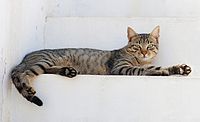
Photo from wikipedia
Objectives The objectives of the current pilot study were to evaluate whether body condition score (BCS) and body weight are significantly related to physical activity counts, and to evaluate potential… Click to show full abstract
Objectives The objectives of the current pilot study were to evaluate whether body condition score (BCS) and body weight are significantly related to physical activity counts, and to evaluate potential interaction between BCS and voluntary physical activity measured over a 14 day period. Methods Ten (five lean, five overweight), neutered, adult American Shorthair cats were selected for this study (median age 4 ± 0.5 years). Cats with a BCS of ⩽3.0 were considered lean, whereas cats with a BCS >3.0 were considered overweight, using a 5-point scale. Cats were housed in a free-living environment with indoor/outdoor access and were individually fed once daily a commercially available dry extruded diet and allowed 1 h to eat. Voluntary physical activity was measured consecutively for 14 days using the Actical Activity Monitors that were worn parallel to the ribs and attached via a harness. Results Lean cats had a greater mean total daily voluntary physical activity (P = 0.0059), and a greater voluntary physical activity during light (P = 0.0023) and dark (P = 0.0446) periods, with overweight cats having 60% of the physical activity of lean cats. Lean cats were more active before feeding and during animal care procedures. These data suggest that lean cats have a greater anticipatory physical activity prior to feeding and are more eager to have social interaction with humans than overweight cats. A significant interaction was observed between day of physical activity measurement and BCS for total daily voluntary physical activity (P = 0.0133) and activity during the light period (P = 0.0016) where lean cats were consistently more active than overweight cats. In general, cats were more active during weekdays vs weekends. Conclusions and relevance The results of this study suggest that overweight cats are less active than lean cats and that voluntary physical activity level appears to be influenced by social interaction with humans.
Journal Title: Journal of Feline Medicine and Surgery
Year Published: 2017
Link to full text (if available)
Share on Social Media: Sign Up to like & get
recommendations!